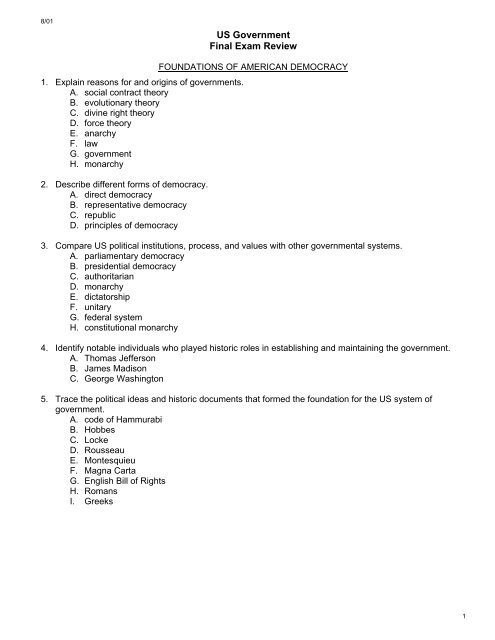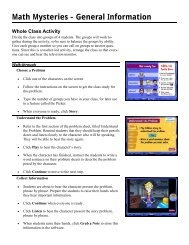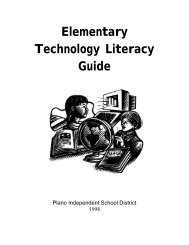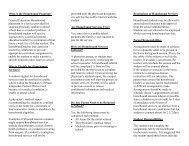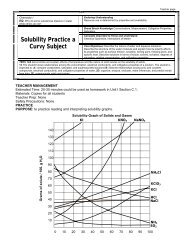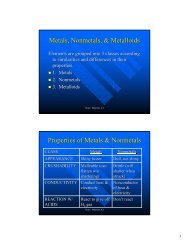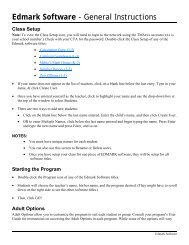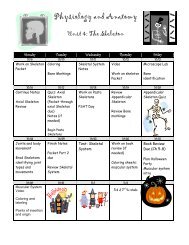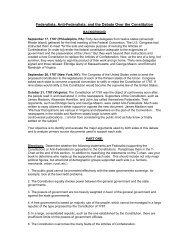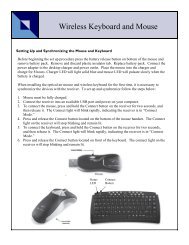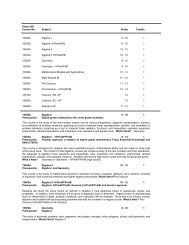US Government Final Exam Review
US Government Final Exam Review
US Government Final Exam Review
You also want an ePaper? Increase the reach of your titles
YUMPU automatically turns print PDFs into web optimized ePapers that Google loves.
8/01<br />
<strong>US</strong> <strong>Government</strong><br />
<strong>Final</strong> <strong>Exam</strong> <strong>Review</strong><br />
1. Explain reasons for and origins of governments.<br />
A. social contract theory<br />
B. evolutionary theory<br />
C. divine right theory<br />
D. force theory<br />
E. anarchy<br />
F. law<br />
G. government<br />
H. monarchy<br />
2. Describe different forms of democracy.<br />
A. direct democracy<br />
B. representative democracy<br />
C. republic<br />
D. principles of democracy<br />
FOUNDATIONS OF AMERICAN DEMOCRACY<br />
3. Compare <strong>US</strong> political institutions, process, and values with other governmental systems.<br />
A. parliamentary democracy<br />
B. presidential democracy<br />
C. authoritarian<br />
D. monarchy<br />
E. dictatorship<br />
F. unitary<br />
G. federal system<br />
H. constitutional monarchy<br />
4. Identify notable individuals who played historic roles in establishing and maintaining the government.<br />
A. Thomas Jefferson<br />
B. James Madison<br />
C. George Washington<br />
5. Trace the political ideas and historic documents that formed the foundation for the <strong>US</strong> system of<br />
government.<br />
A. code of Hammurabi<br />
B. Hobbes<br />
C. Locke<br />
D. Rousseau<br />
E. Montesquieu<br />
F. Magna Carta<br />
G. English Bill of Rights<br />
H. Romans<br />
I. Greeks<br />
1
8/01<br />
6. Analyze the political, economic, and social reasons that led to the writing of:<br />
A. The Declaration of Independence<br />
1. colonial weaknesses<br />
B. <strong>US</strong> Constitution<br />
1. weaknesses of the Articles of Confederation<br />
2. Connecticut Compromise<br />
3. 3/5’s Compromise<br />
4. Commerce and Slave Trade Compromise<br />
C. Bill of Rights<br />
1. protection of individual rights and liberties<br />
D. Federalist Papers<br />
E. Anti-Federalist writings<br />
7. Compare and contrast the arguments for and against the ratification of the Constitution proposed by the<br />
Federalists and Anti-Federalists.<br />
A. lack of Bill of Rights<br />
B. strong Central <strong>Government</strong><br />
C. states rights<br />
8. Understand the basic principles and structure of the <strong>US</strong> Constitution.<br />
A. popular sovereignty<br />
B. separation of powers<br />
C. checks and balances<br />
D. limited government<br />
E. federalism<br />
F. judicial review<br />
G. preamble<br />
H. articles<br />
I. amendments<br />
9. Explain the process of constitutional change.<br />
A. formal amendment process<br />
B. informal changes<br />
10. Analyze the system of checks and balances.<br />
A. powers of each branch<br />
1. Legislative<br />
2. Executive<br />
3. Judicial<br />
B. how each branch checks the others<br />
1. L – J<br />
2. L – E<br />
3. E – L<br />
4. E – J<br />
5. J – L<br />
6. J – E<br />
11. Identify the division of powers between national and state governments.<br />
A. federalism<br />
B. delegated or expressed powers<br />
C. reserved powers<br />
D. concurrent powers<br />
E. denied powers<br />
12. Interpret the concept that the <strong>US</strong> has a “government of law, not of men”<br />
A. <strong>US</strong> Constitution<br />
2
8/01<br />
THE POLITICS OF DEMOCRACY: POLITICAL BEHAVIOR, POLITICAL PARTIES, AND ELECTIONS<br />
1. Trace the development of the two-party system in the <strong>US</strong>.<br />
A. Federalists<br />
B. Anti-Federalist<br />
C. Democrats<br />
D. Republicans<br />
2. Identify notable individuals who played historic roles in establishing political parties.<br />
A. Andrew Jackson<br />
B. Abraham Lincoln<br />
C. Alexander Hamilton<br />
D. Thomas Jefferson<br />
3. Analyze the role of minor political parties, media, and interest groups in the American political process.<br />
A. lobbying<br />
B. alternative issues and candidates<br />
4. Identify factors that influence an individual’s political attitudes and actions.<br />
A. family<br />
B. education<br />
C. socioeconomic position<br />
D. independent voter<br />
5. Identify categories that describe political attitudes.<br />
A. liberal<br />
B. conservative<br />
C. moderate<br />
D. radical<br />
E. reactionary<br />
F. political spectrum<br />
6. Analyze the functions of political parties in the <strong>US</strong> political system.<br />
A. define issues<br />
B. nominate candidates<br />
C. promote compromise<br />
7. Evaluate the involvement and participation of individuals in the <strong>US</strong> political process.<br />
A. political parties<br />
B. interest groups<br />
C. elections<br />
8. Explain the election process.<br />
A. caucus<br />
B. primary<br />
C. party platform<br />
D. national convention<br />
E. popular vote<br />
F. straight ticket<br />
G. split ticket<br />
H. electoral vote<br />
I. suffrage<br />
J. 15 th amendment<br />
K. 19 th amendment<br />
L. 24 th amendment<br />
M. 26 th amendment<br />
3
8/01<br />
THE FEDERAL LEGISLATIVE BRANCH<br />
1. Understand the structure and organization of Congress.<br />
A. Article I<br />
B. bicameral<br />
C. committee system<br />
D. seniority system<br />
E. Congressional leadership<br />
F. Constituents<br />
G. Redistricting<br />
H. Gerrymandering<br />
2. Evaluate the powers of Congress.<br />
A. expressed<br />
B. implied<br />
C. denied<br />
D. McCulloch v Maryland<br />
3. Understand the differences between the House of Representatives and the Senate.<br />
A. constitutional qualifications<br />
B. terms of office<br />
C. exclusive powers<br />
D. filibuster<br />
4. Trace the major steps by which a bill becomes a law.<br />
A. committee system<br />
B. role of interest groups<br />
C. power of the President<br />
5. Understand how the legislative branch interacts with the other two branches through its use of<br />
non-legislative powers.<br />
A. executive powers<br />
B. judicial powers<br />
4
8/01<br />
THE FEDERAL EXECUTIVE BRANCH<br />
1. Understand the structure and organization of the executive branch.<br />
A. Article II<br />
B. President<br />
C. Vice President<br />
D. cabinet<br />
E. bureaucracy<br />
F. Presidential succession<br />
2. Identify the qualifications the office of President and Vice President.<br />
A. Constitutional qualifications<br />
B. Informal qualifications<br />
C. Term of office – 22 nd amendment<br />
3. Analyze the roles and responsibilities of the President.<br />
A. Chief Executive<br />
B. Chief Legislator<br />
C. Chief of State<br />
D. Chief Diplomat<br />
E. Commander-in-Chief<br />
F. Chief of Party<br />
4. Identify the duties of the Vice President.<br />
A. President of the Senate<br />
B. 25 th Amendment<br />
5. Identify the various executive departments and functions of each.<br />
A. Cabinet level departments<br />
6. Understand how the executive branch interacts with the other two branches.<br />
A. judicial powers<br />
1. appointment<br />
2. pardon and reprieve<br />
B. legislative powers<br />
1. veto<br />
2. pocket veto<br />
5
8/01<br />
THE FEDERAL JUDICIAL BRANCH<br />
1. Understand the structure and organization of the judicial branch.<br />
A. Article III<br />
B. District Courts<br />
C. Courts of Appeal<br />
D. <strong>US</strong> Supreme Court<br />
E. jurisdiction<br />
2. Evaluate the selection process for the Supreme Court and other federal judges.<br />
A. constitutional qualifications<br />
B. informal qualifications<br />
C. term of office<br />
D. appointment and approval<br />
3. Describe the functions of the judicial branch.<br />
A. interpretation of constitutional law (judicial review)<br />
B. interpretation and application of statutory law<br />
4. Analyze the impact of <strong>US</strong> Supreme Court decisions on the American governmental system.<br />
A. Marbury v Madison<br />
B. McCulloch v Maryland<br />
C. Gibbons v Ogden<br />
D. Brown v Board of Education<br />
E. Roe v Wade<br />
F. judicial activism<br />
G. judicial restraint<br />
H. opinions of the court<br />
5. Describe the trial process.<br />
A. petit jury<br />
B. grand jury<br />
C. plaintiff<br />
D. defendant<br />
E. criminal case<br />
F. civil case<br />
G. due process<br />
6. Explain how cases reach the Supreme Court.<br />
A. writ of certiorari<br />
B. appellate jurisdiction<br />
C. original jurisdiction<br />
6
8/01<br />
THE RIGHTS OF ALL CITIZENS: CIVIL RIGHTS AND LIBERTY<br />
1. Identify the rights guaranteed by the Bill of Rights, 13 th , 14 th , and 15 th Amendments.<br />
A. civil rights and liberties<br />
B. equal protection clause<br />
C. due process clause(s)<br />
D. establishment clause<br />
E. free exercise clause<br />
2. Analyze the impact of Supreme Court decisions on civil rights and civil liberties.<br />
A. Miranda v Arizona<br />
B. Gideon v Wainwright<br />
C. Engel v Vitale<br />
D. Mapp v Ohio<br />
E. Brown v Board of Education<br />
F. Plessy v Ferguson<br />
G. Dred Scott v Sandford<br />
H. Furman v Georgia<br />
I. Bakke v Board of Regents of California<br />
3. Analyze the concept of due process and its role in the American system of civil rights.<br />
A. affirmative action<br />
B. “reverse” discrimination<br />
C. de jure and de facto segregation<br />
D. probable cause<br />
E. bill of attainder<br />
F. writ of habeas corpus<br />
G. ex post facto law<br />
STATE AND LOCAL GOVERNMENT<br />
1. Compare the structure of Texas (state and local) government to the national government.<br />
A. legislative branch<br />
B. executive branch<br />
C. judicial branch<br />
D. 10 th Amendment<br />
2. Compare taxing and spending functions of national, state, and local levels of government.<br />
A. property tax<br />
B. income tax<br />
C. sales tax<br />
D. federal grants<br />
E. expenditures<br />
7
8/01<br />
AMERICAN POLICY IN A CHANGING WORLD: <strong>US</strong> FOREIGN POLICY<br />
1. Trace and analyze the development of <strong>US</strong> foreign policy.<br />
A. isolationism<br />
B. Monroe Doctrine<br />
C. Truman Doctrine<br />
D. containment<br />
E. internationalism/involvement<br />
F. détente<br />
G. collective security<br />
H. deterrence<br />
I. Post Cold War challenges<br />
2. Identify the goals of American foreign policy.<br />
A. security of the <strong>US</strong><br />
B. human rights<br />
C. democracy<br />
D. economic prosperity<br />
3. Identify individuals and agencies that contribute to the formation of <strong>US</strong> foreign policy.<br />
A. President<br />
B. Congress<br />
C. State Department<br />
D. Defense Department<br />
E. United Nations<br />
OTHER NATIONS: COMPARATIVE GOVERNMENTS<br />
1. Compare and contrast <strong>US</strong> economic systems with other systems.<br />
A. command economy<br />
B. market economy<br />
C. mixed economy<br />
8


